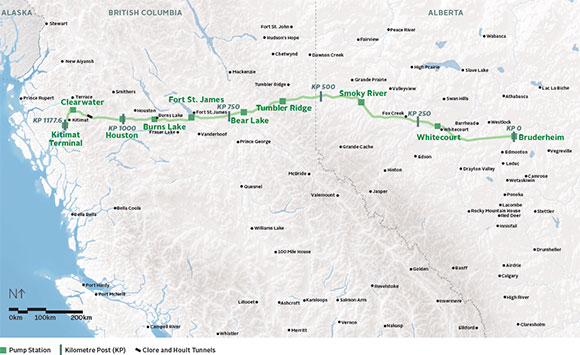Northern Gateway Pipelines Project
Key Facts
- Government committed to restoring public trust in regulatory process
- National Energy Board to dismiss project application
- Protecting sensitive ecosystem of the Douglas Channel, within the Great Bear Rainforest
- Federal Court of Appeal quashed the 2014 project decision

Proposed Pipeline Route
Text Version
The Alberta portion of the proposed pipeline route is about 520 kilometres in length and crosses more than 360 watercourses. About half of the Alberta portion of the route would cross private land and half would cross provincial or federal Crown lands. The British Columbia portion of the proposed pipeline route is about 660 kilometres in length and crosses about 850 watercourses. More than 90 per cent of the British Columbia portion of the route would be on provincial Crown lands. Much of the route in both provinces would cross lands currently and traditionally used by Aboriginal groups.
The Government of Canada has directed the National Energy Board (NEB) to dismiss the Northern Gateway Pipelines project application. The Government has determined that the project is not in the public interest because it would result in crude oil tankers transiting through the sensitive ecosystem of the Douglas Channel, which is part of the Great Bear Rainforest.

Text version
The Great Bear Rainforest is home to the planet's largest intact temperate rainforest stretching some 400 kilometres along the central and north coast of Britsh Columbia.
The rainforest, with its diverse ecosystem of marine life, including whales, sea otters, dolphins and sea lions was admitted to the Queen's Commonwealth Canopy in September 2016.
A three-member Joint Review Panel was established by the Minister of the Environment and the Chair of the NEB in January 2010. The panel was responsible for the environmental assessment and regulatory review of the project, and in December 2013 it submitted its report to the Government.
On June 30, 2016, the Federal Court of Appeal quashed the 2014 decision by the previous government and sent the Joint Review Panel’s recommendation back to the current government for reconsideration.
In making its decision, the Government considered the Joint Review Panel Report, the views of Indigenous communities and those of other Canadians, as represented to the panel, as well as the orders of the Federal Court of Appeal.
The Government determined the project is likely to cause significant adverse environmental effects that are not justified in the circumstances.
Find Out More
Page details
- Date modified: